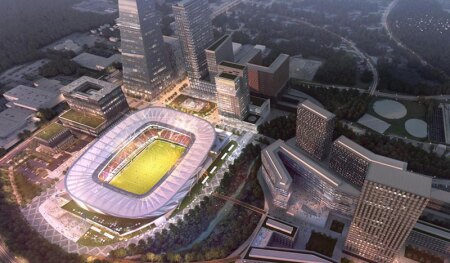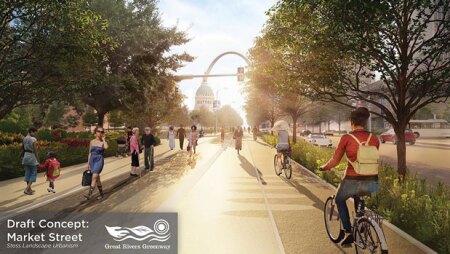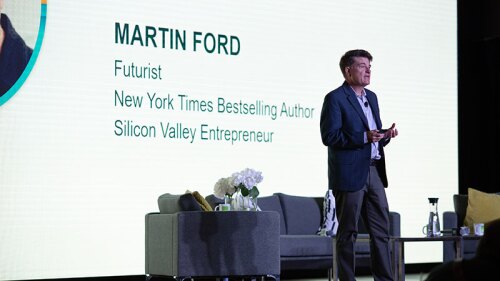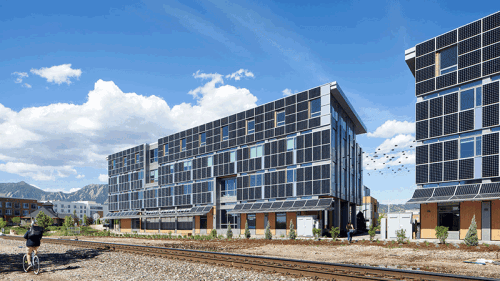Early engagement with the community and inclusion of culturally significant art can create developments that benefit the existing community and lead to greater return on investment.
ULI’s commitment to equitable development is especially important now as recent events spotlight vast inequalities in the United States.
At the time of this writing, more than 189,000 American lives have been lost to the virus causing COVID-19. A disproportionate number of those deaths are among African Americans, many living in poverty and considered at high risk due to poor living conditions. Protests that erupted across the country after the death in Minneapolis of George Floyd, a Black man killed by a White police officer, were powered in part by anger about systemic conditions that for generations have suppressed the economic mobility—and therefore quality of life—of many people of color.
Advancing equitable development—aimed at reducing disparities and promoting healthy, vibrant places—can have a significant positive impact on some of the social challenges of our times. Also important is that equitable development makes good business sense. Studies have shown that regions that value equity and inclusion outperform those that do not and sustain healthy rates of economic growth.
Leaders in real estate development are key contributors to and beneficiaries of healthy economic growth. Equitable development projects that appeal to the senses of a diverse community often employ place-based strategies that encompass art and culture—an approach known as creative placemaking. Even in times of crisis and division, art and culture interventions provide a platform that facilitates communication among diverse groups and across perspectives.
COVID-19 and social unrest are shaping change for the future. There is no doubt that real estate development projects with art and culture features that have been properly vetted for financial viability will yield a healthy return on investment.
What analysts have found, and weeks of national protests punctuate, is that equity and inclusion are a mandate for successful cities and places.
Designing and creating inclusive and equitable places that embrace everyone will help heal centuries of racial injustices and slow or halt displacement that pushes people out of their communities because they can no longer afford them. We do not want to live in a world where the affluent enjoy the amenities of vibrant urban centers and everyone else lives on the edges.
The negative implications of this segmented configuration for economic growth, public safety, health, environmental sustainability, and social cohesion are vast, some of which are playing out in the turbulent times of 2020. Art and culture enable communication and aid in finding common ground among community groups. Art is also an enabler for inclusion, identifying cultural relevance and reflecting it in place. Art helps inspire, inform, and engage.
Urban areas will continue to thrive, albeit in different ways. The pandemic has heightened awareness regarding the value of and need for public spaces. Such spaces that simultaneously enable social distancing and foster social connections will be in high demand, and artfully designed public spaces will help address this need.
Retail shopping is not going away, even in the face of growing e-commerce. This point was made by presenter Lara Marrero of Gensler during a 2020 ULI Spring Meeting webinar titled “The Purpose of Place and Retail’s Great Transformation.” Consumers will still yearn for face-to-face interactions with some retail offerings being more difficult to access or evaluate online, and people will also seek the experience that the retail store engenders. The same is true for food and beverage businesses—restaurants, coffee shops, markets, and the like. All will be attractive for the experiences they offer in a safe, COVID-responsible way. Creative placemaking can help define these experiences.
Real estate developers committed to responsible land use can lead the way in creating more equitable, inclusive, economically thriving communities. Those with a demonstrated track record will expand their brand and business and create better cities and places for all of us.
Two real estate development projects led by ULI members illuminate how creative placemaking strategies can be leveraged to achieve the goals of equitable development and why that is good business from which all stakeholders—developers, the community, government entities, and others—benefit.
Downtown South, Raleigh, North Carolina
Downtown South is an ambitious vision calling for the transformation of 133 acres (54 ha) of largely undeveloped land one mile (1.6 km) south of downtown Raleigh into a $2 billion mixed-use residential, retail, office, and entertainment center.
Downtown South is planned as an exciting gateway to the state capital, welcoming vehicle traffic along South Saunders Street from Interstate 40 and other points south. A central feature of the entertainment center is a 20,000-seat soccer stadium, which could host a professional soccer team, facilitated by the efforts of the North Carolina Football Club. The entertainment center would also accommodate a wide array of other sports and entertainment, including festivals, concerts, and college sports.
A dramatic natural water resource, Walnut Creek, bisects the site, inviting creation of a walkable and bikeable greenway along its banks and enabling access to downtown amenities such as galleries and museums, restaurants, shops, and other popular nearby sites, such as the State Farmers Market and the 308-acre (125 ha) Dorothea Dix Park. Bordering this area to the east is a largely African American community and to the south a largely white community, with each holding varying views and levels of receptivity to the project vision.
Site developer Kane Realty Corporation, in collaboration with the North Carolina Football Club, engaged ULI to convene an Advisory Services panel in August 2019 to answer questions about the feasibility and implications of the Downtown South plans.
At the heart of several questions was equitable development—how to develop the site so it would bring needed jobs, growth, and amenities to the surrounding neighborhoods, preserve cultural heritage, and avoid negative impacts of gentrification such as displacement. An underlying desire was to address historical inequities that had contributed to the disinvestment of African American neighborhoods in the area.
To address these questions, ULI recruited panelists with diverse skills and expertise, including market analysis, urban planning, and real estate development, as well as those with expertise in creative placemaking and community engagement. (This author was a panel member.)
ULI’s recommendations confirmed that Downtown South represents many positive implications for the city and surrounding neighborhoods. Because most new development in Raleigh has been to the west of the city and there has been little development to the south, Downtown South could provide an impressive southern gateway to downtown and the catalyst for other development in nearby neighborhoods.
Raleigh, one of the fastest-growing cities in the country, is attractive to both millennials and businesses because of its long and distinctive list of educational institutions, as well as its affordable cost of living and pro-business environment. The stadium could be an anchor that attracts visitors, residents, and businesses. The entertainment center concept could be enhanced, the panel recommended, by an e-sports facility that could be created through a collaboration with the extensive existing gaming resources in the local business and university community.
While applauding the Downtown South vision, the panel advised that the vision be more expansive, looking beyond the development itself to encompass surrounding neighborhoods. The panel recommended a holistic approach that celebrates the history of south and southeast Raleigh and acknowledges historical challenges that have contributed to the economic disparity among neighborhoods. The panel recommended that a community investment structure be put in place defining how southside neighborhoods would benefit from the anticipated economic growth from development of Downtown South, including more jobs, more affordable housing, and improved neighborhood amenities such as health centers, food access, and art and cultural assets.
The panel also suggested that a comprehensive placemaking and branding plan be developed, leveraging art and engaging neighborhoods to create a shared vision and define a brand representing Downtown South and all southside neighborhoods. This brand could be represented on historical placards placed in each neighborhood to celebrate the unique history of each community. This plan could include artful wayfinding, public art in open spaces, and a cultural heritage trail.
Parts of the development site could be employed for interim uses before and during project construction, such as popup art installations, concerts, and fairs—events that would attract people and build awareness, excitement, and momentum. The ideas for these events, driven by neighborhood input, could be expansive and innovative.
Recognizing that some will resist change or fear the negative effects of gentrification (such as displacement), the panel recommended developing a comprehensive communications and engagement plan to combat these concerns. This plan should be aimed at ensuring that neighborhoods are involved in shaping outcomes, building trust, and maintaining transparency throughout the development of Downtown South.
Guided by panel recommendations, Kane Realty hired APCO Worldwide, an advisory and advocacy communications consulting firm, to develop that engagement plan. The head of APCO’s Raleigh operations, Courtney Crowder, grew up in southeast Raleigh, remained deeply connected to the community, and is highly thought of by many of its residents.
“Courtney is deeply embedded in a wide range of causes in the community, including economic development, health care, education, public safety, affordable housing, and the arts,” says APCO chief executive officer Brad Staples. Crowder’s leadership is helping build trust in the Downtown South project among community members, especially in the largely African American community where he grew up.
Though somewhat slowed by COVID-19, the community engagement work is well underway. As Kane Realty awaits zoning approval for the first phase of development, residents are expected to weigh in on how development of Downtown South can have a positive impact on their neighborhoods. Construction is expected to start in mid-2021.
John Kane, chief executive officer and chairman of Kane Realty, has a stellar reputation in the city. He was described as kind, thoughtful, and sensitive to the needs of the community by many people interviewed during the panel’s day of interviews with local residents, businesspeople, educators, and politicians. His hope is for an equitable and inclusive Downtown South and its surrounding neighborhoods, and he “walks the talk.” Kane Realty’s brand and business have no doubt been bolstered by the leadership’s commitment to creating places where all Raleigh residents can live, work, learn, and enjoy life.
The Brickline Greenway, St. Louis, Missouri
The Brickline Greenway is a massive $250 million project that will transform St. Louis by connecting communities in all directions via a 20-mile (32 km) walkable, bikeable path that meanders through as many as 17 neighborhoods. That path, known as the Brickline, is expected to promote healthy living, enhance access to transit options, and spur economic development. Leading this project is Great Rivers Greenway (GRG), a regional public agency that has been connecting communities in St. Louis via greenways for the past 20 years and is committed to continuing to do so.
Seven signature projects—using a mix of public and private funding and spearheaded by GRG—have been identified on or near the Brickline, and many more are expected to follow. GRG is working on three projects, one of which includes one of the signature projects. The Brickline will enhance access to the city’s many attractions and historical sites. By its design, it will create memorable experiences, connect people to each other in new and inspiring ways, provide education and excitement, contribute to the ecology and environmental sustainability of the city, and more. The Brickline holds the promise of uplifting the many neighborhoods it touches, some of which are underserved and in need of revitalization.
“The Brickline Greenway is different, not just because of its scale and ambition, but because of its process,” says Susan Trautman, chief executive officer of GRG.
The agency looked at many precedent projects before undertaking the Brickline. Team members believe that having a strong vision, values, and intended outcomes steeped in equity and inclusion is critical to success. GRG wanted to avoid unintended outcomes, such as displacement that forces businesses and residents out due to rising property values, making places no longer affordable.
“We wanted residents and businesses to have a say in what happened to them and their neighborhoods,” says Trautman. GRG took a giant step forward by embarking on a community-led effort to guide the project in the early planning phase. A diverse group of 125 individuals, including artists, neighborhood representatives, private funders, city staff, and institutional partners, assembled to help guide decisions about the way the Brickline was planned, designed, and built.
The group included a steering committee, plus four working groups—design, development, and construction; economic development; equity; and governance—and an Artists of Color Council. Hearing the diverse voices presented a challenge but provided meaningful benefits, including the gathering of new ideas and building trust and confidence in the project. Equally meaningful were community outreach activities, which took place at bus stops, pop-up events, open houses, neighborhood meetings, interviews, and other events.
The Artists of Color Council was charged with identifying opportunities to integrate art along the greenway in ways that were culturally relevant and spoke to the history of St. Louis. Art was to be integrated with design in aspirational ways that “unearth, heal, connect, cultivate, envision”—central themes identified by the council to be reflected in various aspects of the Brickline’s design and construction. These aspects included wayfinding, lighting, public art, landscape treatments, infrastructure, and open spaces, among others.
An aim of the Brickline design is to celebrate the diversity, culture, and histories of the unique neighborhoods served by the greenway. Trautman says that GRG employs art in at least two ways:
- Art used in placemaking to reflect the culture of place helps people feel welcome in these public spaces.
- Art can help educate and connect people to the past, and acknowledging the past can help heal a community.
St. Louis artist Damon Davis, part of the Stoss Landscape Urbanism design team that won a competition to do the work, designed an art feature on the Brickline in Mill Creek Valley, a former neighborhood of the historic African American community. The neighborhood was demolished in the 1950s during the wave of “urban renewal” that swept the country—in this case, to make way for an interstate highway, displacing 20,000 St. Louis residents from their homes and businesses. The land surrounding the new interstate lay fallow for years and has since been developed. Davis is designing a series of cathedral-like sculptures, symbolic of the homes and buildings that stood in Mill Creek Valley during its over 200-year history.
As the development of Brickline proceeds to the next phase, GRG continues its commitment to diversity and inclusion through more focused community engagement that taps residents and businesses in neighborhoods where development is slated to begin. This includes three of the six signature areas: Cortex Innovation Community and City Foundry in Midtown St. Louis, the Mill Creek project at 21st Street, and the Fairground area in north St. Louis.
Lamar Johnson Collaborative (LJC) and Marlon Blackwell Associates are leading the current design phase, with LJC managing director Chip Crawford as project lead. Crawford is ideally suited for this role: he is immediate past chair of ULI St. Louis and chair of its Equitable Communities Initiative, committed to fostering equitable development. Crawford brings ULI resources that support achievement of GRG’s equity and inclusion goals. These resources include technical assistance panels, in which a panel of experts provides recommendations to address a development challenge in an intense one-day session, and the Real Estate Development Initiative (REDI), a ULI program funded by a Robert Wood Johnson Foundation grant that provides education and mentoring for developers of color and women to better prepare them as a potential development partners.
The GRG team’s commitment to equitable development is vitally important for a city still struggling to implement the calls to action outlining a path toward racial equality—as laid out in the 2015 Ferguson Commission Report—more intensely now because of the persistent 2020 protests calling for racial equality. The GRG team is serious about this project’s role in creating an equitable and inclusive city where everyone has the opportunity for economic prosperity and a good quality of life.
Like similar projects, such as the Atlanta Beltline and New York City’s Highline, the Brickline is intended to bring millions and perhaps billions of dollars in economic return. In fact, says Steve Smith of the Lawrence Group, developer of the City Foundry STL public marketplace on the Brickline, “I expect that over the next decade, we will see substantial private investment in and along the greenway.” According to analysts, return on these investments will be optimized through effective strategies that deliver equitable benefits for all stakeholders.
Best Practices for Best Outcomes
Downtown South and Brickline Greenway have promising beginnings leveraging creative placemaking in equitable development, but they are in early design stages. There are existing success stories of projects that held the value of equity and inclusion, leading with art and community engagement.
Crosstown Concourse, Memphis
A $250 million adaptive use project in Memphis, Crosstown Concourse transformed a defunct Sears distribution center into a mixed-use urban village. Through its inclusive approach that included a core team of artists and designers, Crosstown Concourse was 98 percent leased when it officially opened its doors in August 2017.
Now, even with the COVID-19 pandemic, the 1.2 million-square-foot (112,000 sq m) project is prospering, largely because it curated a mix of office, commercial, health, education, art, retail, and residential spaces that cater to the needs of the local community.
Todd Richardson, an art historian turned lead developer for Crosstown, reported that in Memphis, with a population that is 70 percent African American, protests in response to the killing of George Floyd have been relatively peaceful. In part, he conjectured, this is because Memphis, with its long history of racial strife, including the assassination of Martin Luther King Jr., has been in conversation on race as a community for a long time.
But talk alone will not quell anger rising from racial inequality. Richardson recently became president of Crosstown Redevelopment Cooperative and is working to create co-op housing in a largely rental neighborhood near Crosstown Concourse, which would yield the opportunity for homeownership by local residents. Efforts like this help build trust and can contribute to building healthy, thriving communities.
11th Street Bridge Park, Washington, D.C.
The 11th Street Bridge Park, a project of the nonprofit group Building Bridges across the River, is working to transform a defunct bridge over the Anacostia River in Washington, D.C., into an urban park and to connect an underserved neighborhood on the river’s east banks to its more affluent neighborhoods on the west.
The development team held more than 200 community meetings before selecting an architect, engaged artists in the bridge design, and through its equitable development plan, attracted $60 million in foundation funding to implement plan actions, which exceeded the initial estimated cost of bridge construction. Total funds raised to date for bridge construction, maintenance, and equitable development actions exceed $114 million.
The project has already attracted investment in areas east of the Anacostia River—a good thing for the area’s businesses and residents, bringing amenities, attracting visitors who patronize local businesses, and promoting inclusive economic growth. The equitable development plan is aimed at helping ensure that all stakeholders benefit from the project growth anticipated in the area and are not displaced by it. Some planned actions include providing education and financial resources for first-time homebuyers, increasing the supply of affordable housing through the formation of a community land trust, leading construction training classes, and providing low-cost loans to nearby small businesses.
Shared Attributes
Several attributes are shared by these two projects, as well as Downtown South and Brickline Greenway:
- a commitment to equitable development in which all stakeholders benefit;
- shared vision, values, and intended outcomes;
- use of art- and culture-led activities as a lever in communications, design, and activation/programming;
- early community engagement; and
- committed partners, both public and private.
These attributes relate to best practices in creative placemaking, such as having a clear vision, engaging artists and the community early in the development process, combining art with design, and having strong public/private partnerships, among others.
Additional insights and strategies can be found in ULI’s 2020 publication Creative Placemaking: Sparking Development with Arts and Culture, which includes details about Crosstown Concourse and the 11th Street Bridge Park, as well as other case studies, best practices, and guidance to implement creative placemaking successfully in development projects. The report can be found on Knowledge Finder.
JUANITA HARDY is the founder and managing principal of Tiger Management Consulting Group, a Silver Spring, Maryland–based leadership and business consulting services firm specializing in executive coaching across industries and creative placemaking in the real estate industry. Hardy was ULI Senior Visiting Fellow for Creative Placemaking from 2016 to 2019 and now serves ULI in a consulting role.




